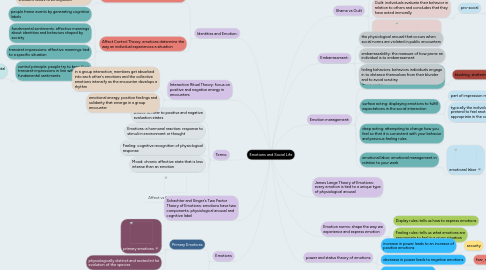
1. Terms:
1.1. Affect: to refer to positive and negative evaluation states
1.2. Emotions: a hormonal reaction; response to stimuli in environment or thought
1.3. Feeling: cognitive recognition of physiological response
1.4. Mood: chronic affective state that is less intense than an emotion
1.5. Affect vs Emotions vs Mood
2. Emotions
2.1. Primary Emotions
2.1.1. primary emotions
2.1.2. physiologically distinct and rooted int he evolution of the species
2.2. Secondary Emotions
2.2.1. emotions are acquired through socialization
2.2.2. pride, shame, guilt, resentment
3. Schachter and Singer's Two Factor Theory of Emotions: emotions have two components: physiological arousal and cognitive label
4. Identities and Emotion:
4.1. Identity Control Theory: emphasizes the role of emotion in self-verification
4.1.1. identity control system: feelings indicate whether or not something in the identity standard needs to be adjusted
4.2. Affect Control Theory: emotions determine the way an individual experiences a situation
4.2.1. people frame events by generating cognitive labels
4.2.2. fundamental sentiments: affective meanings about identities and behaviors shaped by society
4.2.3. transient impressions: affective meanings tied to a specific situation
4.2.4. control principle: people try to keep their transient impressions in line with the fundamental sentiments
4.2.4.1. deflections: disruption between fundamental sentiments and transient impression
4.2.4.1.1. reconstruction principle: people redefine situations where a deflection is too big to repair by reassigning identities to the people involved
5. Interaction Ritual Theory: focus on positive and negative energy in encounters
5.1. in a group interaction, members get absorbed into each other's emotions and the collective emotions intensify as the encounter develops a rhythm
5.2. emotional energy: positive feelings and solidarity that emerge in a group encounter
6. James Lange Theory of Emotions: every emotion is tied to a unique type of physiological arousal
7. Emotion norms: shape the way we experience and express emotion
7.1. Display rules: tells us how to express emotions
7.2. Feeling rules: tells us what emotions are appropriate to feel in a given situation
8. Emotion management:
8.1. emotion management: process through which we control our feelings so that they meet the expectations set by the social encounter and social nows
8.2. surface acting: displaying emotions to fulfill expectations in the social interaction
8.2.1. part of impression management
8.2.2. typically the individual hides their emotions and pretend to feel another emotion that is appropriate in the context of the situation
8.3. deep acting: attempting to change how you feel so that it is consistent with your behavior and previous feeling rules
8.4. emotional labor: emotional management in relation to your work
8.4.1. emotional labor
9. Shame vs Guilt
9.1. Shame: when an individual realizes that another individual, group, or society thinks that they are deficient
9.1.1. anti-social
9.1.1.1. the individual blames the perceived deficiencies on themselves and is reluctant to engage with others
9.2. Guilt: individuals evaluate their behavior in relation to others and concludes that they have acted immorally
9.2.1. pro-social
9.2.1.1. takes on the role of the generalized other and understands why the behavior was harmful
9.2.1.1.1. individual more willing to engage in social encounters to correct their behavior
9.3. the difference between shame and guilt is how an individual perceives themselves
10. Embarrassment:
10.1. the physiological arousal that occurs when social norms are violated in public encounters
10.2. embarrassability: the measure of how prone an individual is to embarrassment
10.3. hiding behaviors: behaviors individuals engage in to distance themselves from their blunder and to avoid scrutiny
10.3.1. blushing, stuttering, avoiding eye contact
11. power and status theory of emotions
11.1. increase in power leads to an increase of positive emotions
11.1.1. security
11.2. decrease in power leads to negative emotions
11.2.1. fear, anxiety
